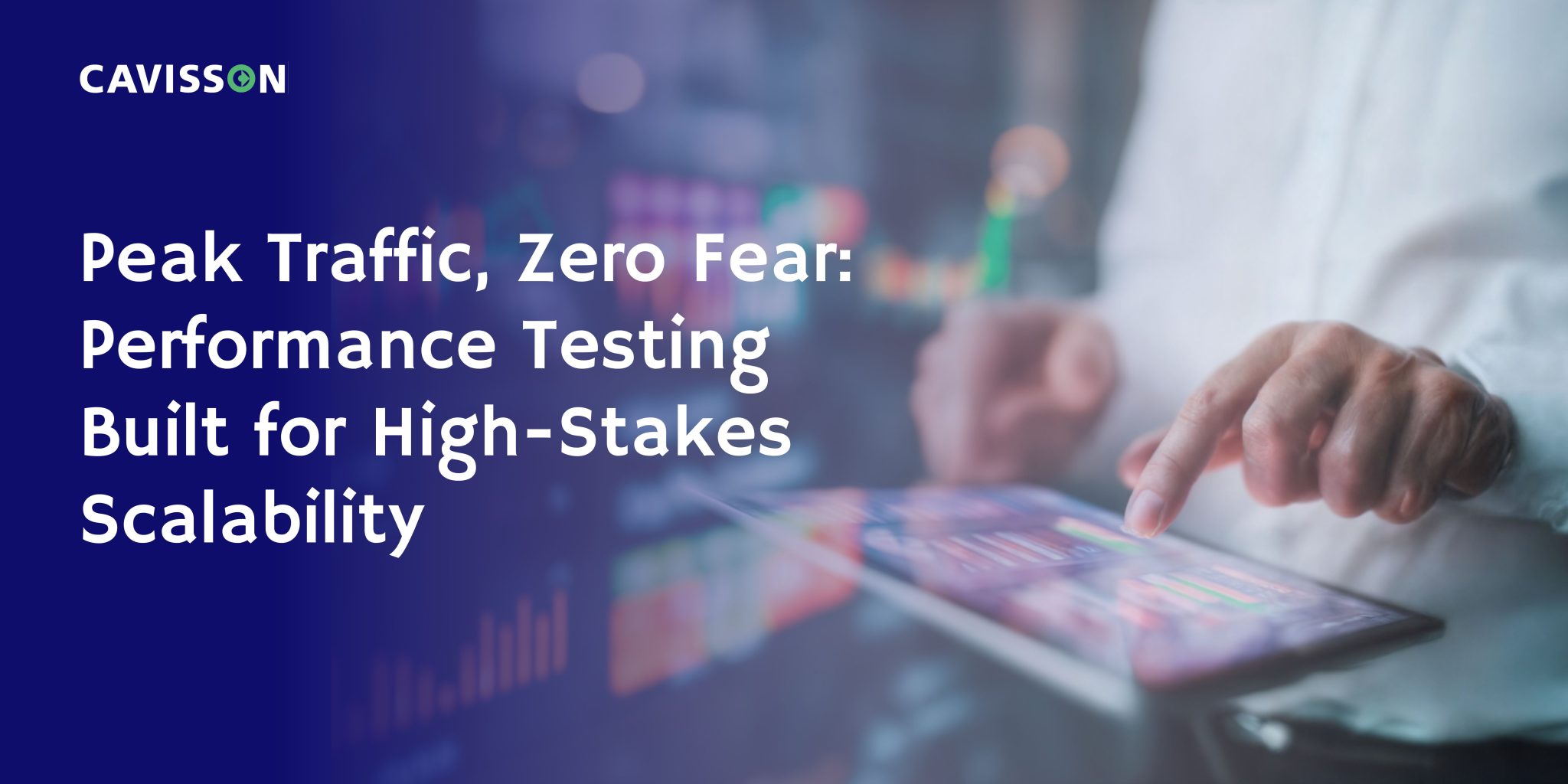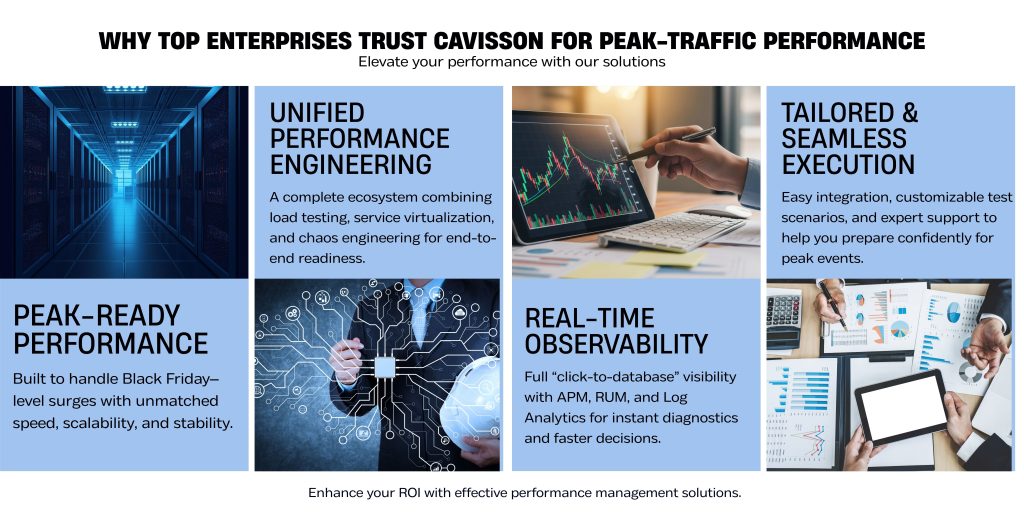
Picture this: It’s Black Friday morning. Your team has been preparing for months. The marketing campaigns are live, the inventory is stocked, and your customers are ready to shop. Then, at 9:00 AM, your website crashes.
Customers can’t check out. Your support team is overwhelmed. Revenue evaporates by the second. And the worst part? You had no idea this was coming.
We’ve seen this nightmare scenario play out too many times. At Cavisson Systems, we work with businesses who’ve lived through these moments, and we help others make sure they never do. Because here’s the thing—performance issues don’t just happen. They’re predictable, preventable, and most importantly, fixable before they ever reach your customers.
Why Peak Load Events Keep Every Tech Leader Up at Night
Let’s be honest: peak-traffic moments are equal parts thrilling and terrifying—not just for CTOs, but for DevOps teams racing to keep systems stable, SREs monitoring every spike, developers owning critical features, and senior management watching revenue dashboards in real time.
Black Friday, major product launches, or viral campaigns—these aren’t just high-traffic events. They’re high-stakes stress tests that expose every weakness in your architecture, code, and operations.
Your system might handle a normal Tuesday perfectly. But when traffic multiplies without warning, everything changes. Every millisecond matters. Every bottleneck shows up. Every missed alert becomes a fire drill.
And we’ve all heard it before: “It worked fine in testing.”
Sure—because testing with a few hundred users is nothing like thousands hitting your APIs, UIs, and checkout flows simultaneously. Real-world peak events push infrastructure, observability, code efficiency, automation, and resilience to their limits.
For every team—whether you’re optimizing code paths, scaling cloud resources, ensuring error budgets aren’t blown, or protecting revenue and brand reputation—peak load events are where preparation meets reality.
The Most Common Peak-Load Failure Patterns
Understanding how systems typically fail helps you prepare strategically. Here are the patterns we see repeatedly:
![]() Database Connection Pool Exhaustion happens when your connection limit is reached, causing requests to queue and timeout. Organizations consistently report revenue losses during holiday sales when database connection pools can’t support massive concurrent user spikes.
Database Connection Pool Exhaustion happens when your connection limit is reached, causing requests to queue and timeout. Organizations consistently report revenue losses during holiday sales when database connection pools can’t support massive concurrent user spikes.
![]() Memory Leaks Under Heavy Load may seem minor during normal operations, but they become catastrophic at scale. Authentication services and user management systems are particularly vulnerable, often crashing within minutes of major launches when memory leaks that were barely noticeable during testing become critical under production load.
Memory Leaks Under Heavy Load may seem minor during normal operations, but they become catastrophic at scale. Authentication services and user management systems are particularly vulnerable, often crashing within minutes of major launches when memory leaks that were barely noticeable during testing become critical under production load.
![]() Third-Party API Cascade Failures occur when external dependencies slow down or fail, blocking your application threads and bringing down critical flows. Checkout processes frequently freeze when third-party inventory or payment APIs degrade from millisecond response times to multi-second delays.
Third-Party API Cascade Failures occur when external dependencies slow down or fail, blocking your application threads and bringing down critical flows. Checkout processes frequently freeze when third-party inventory or payment APIs degrade from millisecond response times to multi-second delays.
![]() Message Queue Overflow creates massive backlogs that delay user notifications and order processing. Email confirmation queues can balloon to millions of messages during high-demand events, leaving customers waiting hours for critical confirmations.
Message Queue Overflow creates massive backlogs that delay user notifications and order processing. Email confirmation queues can balloon to millions of messages during high-demand events, leaving customers waiting hours for critical confirmations.
![]() Network Bandwidth Saturation maxes out network cards or load balancers, causing exponential latency spikes even when CPU and memory resources appear healthy. Database network connections hitting bandwidth limits during major events can increase query latency dramatically.
Network Bandwidth Saturation maxes out network cards or load balancers, causing exponential latency spikes even when CPU and memory resources appear healthy. Database network connections hitting bandwidth limits during major events can increase query latency dramatically.
![]() DNS Resolution Bottlenecks emerge in microservices architectures where numerous API calls overwhelm DNS servers. Microservices making hundreds of calls per transaction can generate hundreds of thousands of DNS queries per second during peak loads, degrading entire application chains.
DNS Resolution Bottlenecks emerge in microservices architectures where numerous API calls overwhelm DNS servers. Microservices making hundreds of calls per transaction can generate hundreds of thousands of DNS queries per second during peak loads, degrading entire application chains.
Real-World Simulation: The Foundation of Effective Testing
Performance testing must scientifically replicate actual user behavior and business conditions, not just generate random traffic against your servers.
Focus on Business Outcomes, Not Just Numbers
Instead of asking “How many concurrent users can we handle?” we help you answer questions like:
- Can thousands of concurrent users complete checkout quickly during Black Friday?
- Will search remain responsive when massive user volumes land on the site immediately after major advertising?
- Can video streaming sustain large-scale simultaneous viewership without buffering?
- How does the entire system react when a critical payment API times out?
These scenario-based questions uncover risks that simple concurrency counts completely miss.
Testing Your Complete Technology Stack
Performance failures can occur at any layer of your architecture. Comprehensive testing requires examining every component:
Web Applications need testing that goes beyond simple load generation. We evaluate page load metrics, single-page application API calls, lazy loading behavior, and third-party script impact using browser-based testing that captures the complete user experience, including JavaScript execution delays.
Mobile Apps present unique challenges. We simulate varying network conditions from 3G to 5G, test API efficiency to prevent battery drain, and validate push notification scalability at massive scale. Optimizing mobile app API calls can dramatically reduce load times across slower network connections, significantly improving user satisfaction.
APIs and Microservices require specialized testing of rate limiting, cascading call chain latency, circuit breaker effectiveness, and bulkhead isolation. Our AI-driven scripting generates realistic call graphs that accurately reflect production traffic patterns.
Backend and Database layers need testing of connection pool sizing, query performance under load, cache hit ratios, batch processing impact, and failover recovery. Right-sizing connection pools often improves performance by eliminating unnecessary overhead.
AI-Powered Performance Testing: The Cavisson Advantage
At Cavisson Systems, we’ve integrated artificial intelligence throughout our performance testing platform to deliver smarter, more effective testing:
Learning From Production: Our tools continuously monitor live traffic, extracting actual user journeys and failure patterns to automatically generate realistic test scripts.
Intelligent Load Modeling: Rather than blindly scaling up user counts, our AI projects future growth patterns and seasonal behavior changes based on your actual business trajectory.
Anomaly Injection: We simulate realistic failure scenarios like slow payment gateways, intermittent third-party errors, and partial service degradation to test your system’s resilience under adverse conditions.
AI-Enabled Regression Detection: Our platform learns the dynamic baseline of your normal system behavior, automatically detecting subtle performance degradations that would otherwise go unnoticed until they become critical problems.
Why Top Enterprises Trust Cavisson for Peak-Traffic Performance
Peak-traffic events are high-stakes moments that demand flawless application performance. At Cavisson Systems, we help you prepare with confidence. Our performance engineering ecosystem ensures your applications remain fast, stable, and scalable—even at unprecedented load levels.

1. Unmatched Performance & Scalability
Cavisson’s performance engineering suite—Performance Testing, Service Virtualization, and Chaos Engineering—is built for ultra-high scalability. Whether it’s Black Friday, a product drop, or a viral campaign, our tools ensure your applications perform consistently under the heaviest load without compromising user experience or service reliability.
- Complete End-to-End Performance Ecosystem
Cavisson delivers a unified, enterprise-grade testing stack that covers every performance dimension:
- Performance Testing: Simulates realistic, complex user behavior and accurately validates system capacity.
- Service Virtualization: Reproduces real-world dependencies, slow networks, and unpredictable conditions to validate performance under any environment.
- Chaos Engineering: Injects controlled failures to uncover hidden weaknesses and build true system resilience.
Together, they provide the accuracy, depth, and coverage needed for thorough high-traffic readiness.
- Cost-Effective Peak Season Preparedness
Preparing for extreme traffic shouldn’t drain your budget. Cavisson helps teams avoid costly downtime and revenue loss by maximizing resource utilization, improving infrastructure efficiency, and ensuring applications are architected for sustained peak performance—delivering exceptional ROI during high-demand seasons.
- Real-Time, Actionable Insights
Cavisson’s unified observability platform empowers teams with intelligent, real-time performance analytics:
- Application Performance Monitoring: Code-level visibility, distributed tracing, and instant diagnostics to identify slow transactions and backend bottlenecks within seconds.
- Real User Monitoring: Understand exactly how real users experience your application, correlating frontend interactions with backend performance for precise root-cause analysis.
- Log Monitoring: High-speed, real-time log analytics with immediate search, anomaly detection, and correlation across metrics and sessions.
This complete “click-to-database” visibility helps teams detect issues early, optimize performance proactively, and ensure zero surprises during peak events.
- Seamless Integration into Any Environment
Cavisson integrates effortlessly with cloud, on-premise, and hybrid architectures. Deployment is quick, frictionless, and requires no major architectural changes—ensuring you’re ready for peak season without operational disruption.
- Tailored Testing for Your Unique Traffic Patterns
Every business has distinct user flows and peak periods. Cavisson enables fully customizable test scenarios tailored to your industry, user behavior, and application architecture—ensuring you’re not just prepared, but precisely aligned to the real conditions your systems will face.
- Industry-Leading Customer Support
High-stakes events demand expert guidance. Cavisson’s customer engineering team provides proactive, end-to-end support—from planning to execution—ensuring your performance strategy is rock-solid and your systems are peak-ready.
Performance Isn’t Just Technical—It’s Personal
Let’s step back from technology for a moment and talk about what this really means.
Every millisecond of latency isn’t just a technical metric—it’s a customer deciding whether to wait or go to your competitor. Every failed checkout isn’t just a dropped transaction—it’s someone who might never trust your site again. Every timeout error isn’t just a log entry—it’s revenue walking out the door.
The organizations that dominate their markets aren’t lucky. They’re prepared. They’ve done the hard work of breaking their systems intentionally, in controlled environments, so they know exactly what to expect when real traffic hits.
They sleep soundly before big launches because they’ve already seen the worst their infrastructure can throw at them, and they’ve fixed it all.
The Choice Is Yours
You can keep hoping your systems will handle the next big moment. Hope that this launch will be different. Hope that traffic won’t be quite as heavy as you fear.
Or you can know.
You can test, measure, fix, and validate. You can walk into peak season with absolute confidence. You can turn your infrastructure from a question mark into a competitive advantage.
Every day without comprehensive performance testing is a day you’re operating blind. Meanwhile, your competitors are testing, optimizing, and building systems they can trust completely.
The question isn’t whether you can afford to invest in performance testing. It’s whether you can afford to keep gambling with your business.
Ready to stop hoping and start knowing? Let’s talk. Contact Cavisson Systems and discover how our performance testing solutions can transform your infrastructure from a liability into your secret weapon.
Because in the end, the best way to handle a performance crisis is to make sure it never happens in the first place.

